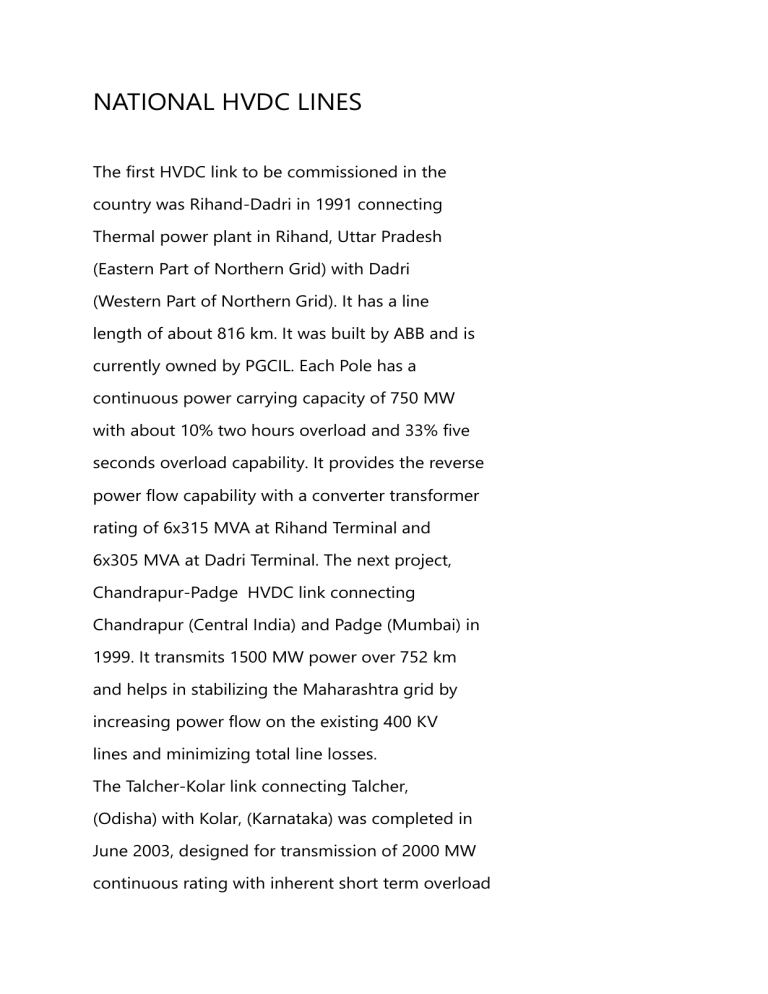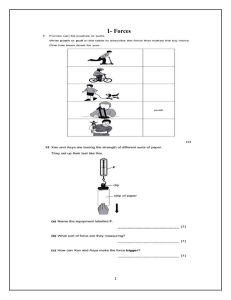
NATIONAL HVDC LINES The first HVDC link to be commissioned in the country was Rihand-Dadri in 1991 connecting Thermal power plant in Rihand, Uttar Pradesh (Eastern Part of Northern Grid) with Dadri (Western Part of Northern Grid). It has a line length of about 816 km. It was built by ABB and is currently owned by PGCIL. Each Pole has a continuous power carrying capacity of 750 MW with about 10% two hours overload and 33% five seconds overload capability. It provides the reverse power flow capability with a converter transformer rating of 6x315 MVA at Rihand Terminal and 6x305 MVA at Dadri Terminal. The next project, Chandrapur-Padge HVDC link connecting Chandrapur (Central India) and Padge (Mumbai) in 1999. It transmits 1500 MW power over 752 km and helps in stabilizing the Maharashtra grid by increasing power flow on the existing 400 KV lines and minimizing total line losses. The Talcher-Kolar link connecting Talcher, (Odisha) with Kolar, (Karnataka) was completed in June 2003, designed for transmission of 2000 MW continuous rating with inherent short term overload capacity over 1369 km, making it the longest HVDC link with a converter transformer rating of 6x398 MVA. The 780 km HVDC link connecting Ballia, Uttar Pradesh and Bhiwadi , Rajasthan in monopolar mode in March 2010 and was furthered to operate in bipolar mode in March 2011. During inclement weather conditions it operates at 70-80% DC voltage owing to reverse power flow capability with a converter transformer rating of 8x498 MVA on both side. The Mundra-Mohindergarh link has been the most recently commissioned HVDC link connecting the Western region to the Northern region for over 986 km operating at 1500 MW. It is the first link to be commissioned by a private firm LOAD DEMAND TREND Indian Power sector is going through a phenomenal transformation, impact of renewable energy penetration in the overall energy mix being one of the major areas of thrust. In order to judiciously increase the share of Renewable in the Energy composition, a meticulous analysis of the current electricity demand pattern is a mandate. This contemplation and forecast is necessary for laying down the foundation of future course of action. The ambitious target of 227 GW of Renewable Energy installed capacity by 2022 calls for the aforesaid analysis cascading its prominence over the upcoming years. Above figure depicts the All India Load-Curve on hourly basis. Night lean is around 4am to 5am followed by almost a steep and abrupt rise to Morning Peak which is around 8am to 9am due to increase in industrial and commercial consumption. The period from 1pm to 3pm can be designated as a day lean and finally peaking in the evening from 5pm to 8pm. Thus, it can be inference that India is a country with peak during evening (5pm8pm approx.) about 145034 MW at 8pm. This is resorted to residential lighting, HVAC and manufacturing industries' consumption forming a major chunk of consumption whereas commercial consumption is almost drooping during this time. The consumption although mainly depends upon weather condition, time of the day and load profile of the consumer. Moreover, the demand is relatively higher in summers than in winters. Above figure depicts the All India Load Duration Curve representing the no. of hours a particular level of load is required during a day. It is evident from the curve that around 115000 MW of average demand is during 80% of the time of the day which suggests that optimum base load capacity should not deviate much from this value which when compared to conventional installed capacity reflects significant over supply. Over FY10-FY18, the electricity production in India grew at Compound Annual Growth Rate (CAGR) of around 6 % (IBEF Reference), if same growth rate is considered then the extrapolation of base load capacity and conventional installed capacity implies that over-supply problem shall still be prominent if not addressed meticulously. The resources like gas/hydro etc. may be utilized for peaks and median capacities. This shall cater optimization of Plant Load Factor and Economics of generation. Now, to match this abrupt demand pattern with generation pattern in order to meet the power deficit, flexible base load, peak load and storage options like coal, hydro, pumped storage etc. are captivating comrades. Solar and Wind cannot completely meet the present load pattern as Solar is not available during night time and wind power is intermittent. Moreover, Renewable penetration shall also lead to increase in the requirement of ancillary support services. Referring to the above plot, it can be inference that electricity consumption has a good correlation with per capita income. Higher per capita income demands for loads like ACs, Refrigerators, Water Heaters etc. driving the demand of electricity. Chandigarh, Delhi, Goa, Maharashtra and Tamil Nadu that have relatively high per capita income show relatively higher per capita electricity consumption (refer state-wise load-duration curve above). Chhattisgarh and Odisha being anomalous, despite significantly lower per capita income, the electricity consumption is almost similar to that of the higher per capita income regions. This is perhaps due to concentration of electricity-intensive heavy industries like aluminium and steel in the states. In order to judiciously plan the capacity expansion and generation in future, the tariffs may be driven by consumer load profile. In addition, there should not be the concentration of heavy industries only at some places, for instance, load duration curve of Maharashtra is far above the others. Education, healthcare and infrastructure development also pay a pivotal role in determining the electricity demand. The fact of the matter is that residential and commercial customers have more volatile and perturb load curve unlike industrial consumers which are quite consistent, so tariffs for residential and commercial customers should be higher which is not the case with India where industrial consumers subsidize the residential and commercial consumers. Lower tariffs for industrial consumers can generate an appreciable amount of revenue as industrial load is almost available consistently for 24 hours. Time based tariff can also be thought of in this aspect. Thus, in a nutshell it can be asserted that there is an urgent exigency for tariff restructuring. INTERNATIONAL INTER CONNECTION India is centrally placed in South Asian region and with cross border interconnections with neighbouring countries, playing a major role in effective utilization of regional resources. Further, to facilitate import/ export of electricity between India and neighbouring countries, Ministry of Power, Govt. of India have issued the "Guidelines for Import/Export (Cross Border) of Electricity-2018" on 18th December, 2018. India have also developed expertise in high capacity high voltage transmission projects including AC 400kV and 765kV and HVDC systems. Presently, India is connected with Nepal, Bhutan, Bangladesh and Myanmar. Country wise details are as under: India – Nepal Nepal is interconnected with India at various places through 11kV, 33kV, 132kV and 220kV lines. For transfer of bulk power, interconnection between India and Nepal through Dhalkebar (Nepal) - Muzaffarpur (India) 400kV D/C transmission line has been constructed. A total of about 700 MW of power is being supplied to Nepal through these interconnections. Further, 400kV D/C Gorakhpur (India) – Butwal (Nepal) line, 400kV D/C Dhalkebar (Nepal) – Sitamarhi (India) line, 132kV D/C Nanpara, Bihar (India) – Kohalpur (Nepal), stringing of second circuit of 132kV line Kataiya (India) – Kushaha (Nepal) and 132 kV Raxaul (India) – Parwanipur (Nepal) lines have been agreed. India – Bhutan India and Bhutan already are connected through various 400kV, 220kV and 132kV lines, mainly for import of about 2000 MW power from Tala HEP (1020MW), Chukha HEP (336MW), Kurichu HEP(60MW) and Mangdechu HEP (720 MW) in Bhutan to India. Further, Punatsangchu-I (1200 MW) and Punatsangchu-II (1020 MW) HEPs in Bhutan, are expected to be commissioned by 2024-25. The transmission system for transfer of this power from these projects to India is already in place. With the commissioning of these HEPs the power transfer between Bhutan and India would be enhanced to about 4200 MW. India – Bangladesh A high capacity interconnection between India and Bangladesh exists through Baharampur (India) – Bheramara (Bangladesh) 400kV D/C lines along with 2x500 MW HVDC back-to-back terminal at Bheramara. Another 400kV (operated at 132kV) interconnection exits between Surajmaninagar (Tripura) in India to Comilla in Bangladesh. These interconnections cumulatively facilitate transfer of power of the order of 1160MW to Bangladesh. Further, to enable more intra-regional electricity trade, including competitively-priced power generated from Hydro-electric power projects in India, Nepal and Bhutan; development a 765kV Double Circuit cross-border electricity interconnection between Katihar (India), Parbotipur (Bangladesh) and Bornagar (India) was agreed in the India-Bangladesh Joint Statement during Official Visit of Prime Minister of Bangladesh to India. India – Myanmar India is providing about 3 MW of power from Moreh in Manipur (India) to Tamu town in Myanmar through 11 kV transmission line. Strengthening of more low capacity links at various places along the border is being jointly worked out. High capacity link between the countries is also under discussion. India – Sri Lanka Interconnection between India and Sri Lanka is under discussion between the two countries.




